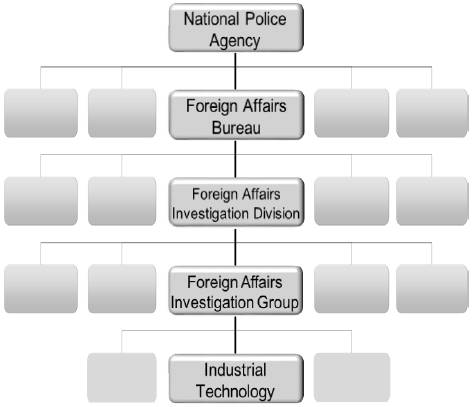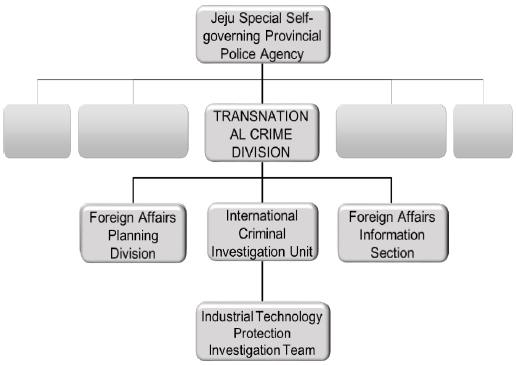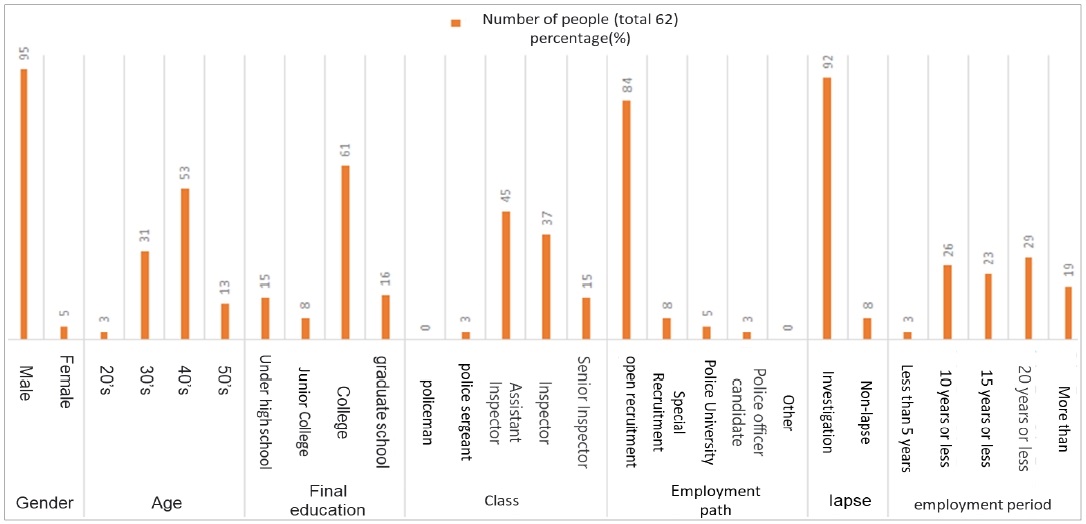
AHP 방법 이용한 경찰의 산업기술보호 분야 역량 강화 방안
*제주지방경찰청 국제범죄수사대**제주대학교 융합정보보안학협동과정 박사과정
***제주대학교 초등교육학과 교수(교신저자)
초록
경찰청에서는 산업기술 보호활동의 강화를 주 목적으로 전국 지방경찰청에 산업기술보호수사팀을 설치하였다. 하지만 현재 대부분의 지방경찰청서에서 경험을 가진 산업기술수사관은 일반적으로 4명 이하이며, 근무 기간이 1년 미만의 신임 수사관도 상당하여 실질적인 산업기술보호 분야 업무 수행이 어려운 상황으로 역량 강화가 요구된다. 본 논문은 산업기술수사관의 역량 강화를 통해 강화된 산업기술 보호를 목적으로 전국 산업기술보호수사팀에서 근무하고 있는 수사관을 대상으로 역량 강화에 요구되는 요소에 대한 설문조사를 하고, 경찰의 산업기술보호 분야 역량 강화에 가장 필요한 역량을 1계층과 2계층으로 구분하여 계층별로 요구되는 역량을 AHP 방식을 통해 분석하였다. 본 연구는 향후 산업기술수사관 역량 강화를 위한 토대가 되는 정보를 제공하는 것을 목적으로 한다.
Abstract
The National Police Agency established an investigation team for industrial technology protection at local police offices nationwide with the main purpose of strengthening industrial technology protection activities. Currently, however, there are less than four industrial technology investigators with experience in most local police stations, and many new investigators with less than one year of service are also required to strengthen their capabilities as they are difficult to carry out their duties in the field of industrial technology protection. This paper conducted a survey on the factors required to strengthen the capacity of the national industrial technology protection investigation team for the purpose of protecting the enhanced industrial technology through the enhancement of the capacity of the industrial technology investigator, and analyzed the required capacity by class by dividing the capacity needed most for the police in the field of industrial technology protection into the first and second layers through the AHP method. The purpose of this study is to provide information that is the basis for strengthening the capacity of industrial technical investigators in the future.
Keywords:
police, industrial technology protection, leakage, industrial espionage, investigation, capacity, reinforcement, AHPⅠ. 서 론
우리나라는 과거에는 선진문물을 받아들이는 입장에서 선진국으로부터 기술 도입을 해야 하는 입장이었다. 하지만 이제는 오히려 중국 등 세계 각국으로부터 첨단기술유출의 주요 대상국이 되고 있으며, 실제로 많은 분야에서 일부 국내 기업의 핵심 기술이 해외로 유출되고 있다. 이러한 해외 유출은 피해 기업의 손실을 가져올 뿐만 아니라 국내산업 전반의 경쟁력 약화 및 국가안보에도 큰 위협이 되고 있다.
하지만 첨단기술유출에 대한 수사를 전담하는 산업기술보호수사팀에서 실질적인 경력을 가진 수사관은 평균 4명 이하이며, 1년 이내의 신임 수사관의 수가 적지 않아 실질적인 산업 보호 수사 능력을 보유하고 있기 어려우며, 근래에 설치된 산업기술보호수사팀의 역량에 대한 의문을 가질수 있도록 한다. 이는 기관의 신뢰성에 대한 문제가 될 수 있으며, 기관에서는 신뢰성을 증명하기 위해 속한 수사관들이 전문적인 기술을 가진 신뢰할 수 있는 역량을 보유하고 있음을 증명하여야 한다. 하지만 신설된 기관은 실질적으로 시간에 의해 축척된 가이드라인을 제시하는 것에 어려움을 가지며, 수사관의 역량에 대한 근거가 되는 자료가 요구된다.
본 논문에서는 IT산업 발전에 따른 산업기술유출 동향과 산업기술보호의 중요성을 이론적으로 검토하고, 경찰청 산업기술보호 수사팀에서 현재 근무하고 있는 수사관 중심으로 설문조사를 통해 경찰의 산업기술보호 분야 역량 강화 방안에 대해 바람직한 방안을 모색하고자 한다.
Ⅱ. 이론적 배경
2.1 산업기술보호 수사팀 신설
경찰청에서는 범정부 차원에서 추진하는 산업기술유출 규제정책 기조에 발맞추고자 2010년 산업기술유출 수사지원센터 발대식을 시작으로 전국 6개 지방경찰청에 산업기술유출 수사팀을 신설하였다. 이후 2017년 2월에 전국 지방경찰청으로 확대하였으며, 산업기술유출 수사활동 뿐만 아니라 기업체 보안진단, 유출 예방 활동으로 업무를 확장하면서 2019년 2월에 산업기술보호수사팀으로 변경하였다[1][2].
2.2 산업기술보호 수사팀 업무
경찰청은 기본적인 업무에 대해 가이드라인을 제시하고 실질적인 사무분장은 각 지방경찰청 사무분장 규칙에 규정하고 있다. 하지만 산업기술보호 수사팀은 아직까지도 구체적인 업무가 사무분장 규칙에 규정되지 않았고 경찰청에서 하달하는 ‘산업기술보호 및 수사강화 종합계획’상 산업기술유출 및 영업비밀 사건 수사 등으로 규정되어 있다.
2.3 산업기술보호 수사팀 조직도 및 구성현황
산업기술보호 수사팀은 경찰청 외사국 외사수사과 외사수사계 내 산업기술보호 수사반에 불과하며, 각 지방경찰청 내에서도 보안과에 속한 지방청도 있지만 대부분은 외사과에 편제되어 있는 것이 일반적이다. 산업기술보호 수사팀은 사무분장에 따라 다음 그림 1, 그림 2와 같이 편제되어 있다[1].
2.4 산업기술 보호 연구
산업기술은 있는 그대로 해석하면 산업에 이용가능한 기술 혹은 산업적으로 활용할 수 있는 기술을 의미한다. 그리고 산업기술보호법상의 산업기술이란 제품 및 용역의 생간, 사용, 보급에 필요한 제반방법 또는 기술상의 정보중에서 행정 기관의 장이 산업경쟁력 제고나 유출방지를 위해 이 법 또는 다른 법률 등에 지정·고시·공고한 기술이다[1]-[7].
산업기술유출 범죄는 소속 조직의 내부자 또는 산업스파이 등 외부자가 기업의 영업비밀 등을 유출하는 범죄를 의미하고, 이론적으로는 산업보안 범죄의 일부분에 해당하며, 경찰청 사건 업무분장을 기준으로 정의하는 경찰실무상의 범죄를 의미한다[1][7][8]-[12].
산업기술보호는 있는 그대로 해석하면 산업에 이용 가능한 기술을 보호한다는 것을 의미한다. 우리나라에서는 1989년 당시 국가안전기획부(현재 국가정보원)가 노태우 대통령에게 산업기술 보호대책의 필요성을 보고하고, 그에 대한 후속조치로 ‘첨단산업기술 보호대책’을 보고하면서 산업기술보호의 개념이 도입되었다[1][7][12].
경찰청에 의하면, 산업기술유출 사건 연도별 검거현황은 2016년 114건, 2017년 140건, 2018년 117건, 2019년 112건으로 해마다 100건이 넘고, 산업기술유출 범죄는 그 수법이 지능적이고 은밀하게 진행되기 때문에 실제 발생건수는 검거건수에 비해 훨씬 많을 것으로 추정하고 있다[1][2][12].
검거현황은, 기업 규모별로 보면, 대기업 보다 중소기업이 많고 중소기업 피해사건이 약 86%를 차지하고 있다. 유출 국가별로 보면, 해외유출이 15% 정도 되는데, 그 해외유출 중 57%가 중국으로 유출되는 것이다. 유출 분야별로 보면, 전기전자, 정보통신, 정밀기계, 생명공학, 자동차, 철강조선에 이르기까지 광범위한 분야에서 기술유출이 발생하고 있고, 유출자의 신분을 보면, 내부자에 의한 유출이 89%를 차지하고 있다[1].
역량에 관해서는 국내외 다양한 분야에서 연구되었고, 경찰의 전문성 강화를 위한 선행연구도 다수 있지만 경찰의 산업기술보호 분야 관련해서는 산업기술수사팀이 신설된 지 얼마 되지 않아 많지 않다.
현대 사회에서 사용하는 역량이란 개념은 1960년대 말에 심리학에서 시작되었는데, McClelland는 전통적인 학업에 관한 적성검사와 성취도 검사의 문제점을 지적하고 이를 대체 할 수 있는 역량이라는 개념을 사용하였다. 그 역량이라는 개념에는 지능에서 중요하게 생각하는 영역 이외에 개인이 성격과 동기가 포함되어 있으며, 지능은 실제 인생에서 적응 정도를 나타내지 못하기 때문에 실제 성과로 측정할 수 있는 역량을 평가의 대상으로 삼아야 한다고 주장 하였다[1][2][5][7][10]-[28].
Ⅲ. 산업기술보호 역량강화 방안
3.1 연구모형 및 연구대상
3.2 변수의 조작적 정의
본 논문에서 사용된 조작적 정의는 표 5와 같이우선 경찰의 산업기술보호 분야 역량 측정을 위해 제1계층에 지식, 기술, 태도로 구분하였다. 그리고 제2계층은 위 1계층에 대한 세부항목으로 각 5개씩을 선정하였다.
3.3 분석 방법
본 논문에서 사용하는 계층적 분석기법(AHP : Analytic Hierarchy Process)은 1976년 펜실베니아 대학 Thomas L. Saatty 교수가 의사결정 비능률을 개선하기 위해 개발한 것으로 의사결정 선택에 있어서 여러가지 대안 중 우선순위를 정할 때 주로 이용(Saatty, 1980) 되는데, 기존 의사결정법으로 수량화하기 어려운 주관적 판단을 계량화하여 사람의 사고방식과 유사한 접근 방법으로 문제를 구조화시켜 정량분석에 유용하다[1][2][5][7][13].
위에서 제시한 연구모형과 같이 4단계의 AHP 단계별 절차를 거쳐 항목요인 간의 쌍대비교 후 표기된 수치를 통해 가중치 및 일관성 지수를 산출하였으며, 이 연구에서는 정형화된 AHP 매뉴얼(AHP를 위한 DRESS)을 사용하여 자동으로 수치를 산출하였다[1][2][5][7][13][35][36].
Ⅳ. 산업기술보호 수사관의 역량분석 결과
4.1 분석 방법
이 논문에서 설문대상자의 인구 사회학적 특성은 표 6을 통해 확인할 수 있다[29][0]. 먼저, 전국 17개 지방경찰청 소속 산업기술팀에 근무하는 수사관은 총 79명이고, 이 중 62명(79%)에 대해서만 분석하였다. 62명의 설문 분석 수사관은 남자 59명, 여자 3명이 응답하였고, 연령은 40대 33명, 30대 19명, 50대 8명, 20대 2명 순으로 나타났다.
학력은 대학 졸업 38명, 대학원 이상 10명, 고졸 9명, 전문대 졸업 5명 순으로 나타났다. 계급은 경사 28명, 경위 23명, 경감 이상 9명, 경장 2명 순으로 나타났다. 경찰공무원으로 총재직 기간은 16년 이상∼20년 이하 18명, 6년 이상∼10년 이하 16명, 11년 이상∼15년 이하 14명, 21년 이상 12명, 5년 이하 2명 순이고, 현재 산업기술유출범죄 수사팀에서의 근무기간은 2년 이상∼3년 이하 21명, 1년 이하 15명, 6년 이상∼7년 이하와 4년 이상∼5년 이하 11명으로 동일하고, 8년 이상 4명 순으로 나타났다. 경찰 입직경로는 순경채용 52명, 경장특채 5명, 경찰대학 3명, 간부후보 2명으로 나타났다. 또한 경과는 수사경과 59명, 비경과 5명으로 나타났다[1][2][5][7][13][37]-[39].
그림 4는 성별, 연령, 최종학력, 계급, 입직 경로, 경과, 전체 근무기관 순으로 조사대상인 산업기술 수사관의 특성을 보이는 것이다[31]-[34][40][41].
Ⅴ. 결 론
본 논문의 목적은 산업기술팀을 전국 지방경찰청에 신설했으나 경찰의 산업기술보호 분야에 미흡한 부분이 있어 역량 강화를 위해 산업기술보호 수사관을 대상으로 역량 강화 중요도를 파악하였다.
대부분의 선행연구는 경찰관의 역량 강화 방안으로 조직체계의 정비 및 인원 확대, 예산 및 장비 지원, 전문화 문제만을 논의하였으나 설문조사 없이 일반론적 대응방안을 제시하거나, 설문조사를 했어도 산업기술팀에서 근무하지 않은 일반 경찰관을 대상으로 설문조사를 하여 분석한 것이다. 본 연구는 2020년 5월 현재 산업기술보호수사팀에서 근무하는 수사관 총 79명을 대상으로 설문지를 배포하여, 64명에게 이메일 등으로 회수하여 산업기술보호 수사관 입장에서 경찰의 산업기술보호를 위한 역량 강화방안의 필요성과 중요도를 계층적 분석방법인 AHP 방식으로 측정하였고 그 결과는 다음과 같다.
첫째, 산업기술보호 수사관의 인식에 있어서 제1계층 영역에서 상대적 중요도를 보면, 지식, 기술, 태도 순으로 우선순위가 나타났다. 둘째, 산업기술보호 수사관의 인식에 있어서 제2계층 요소에서 상대적 중요도를 보면, 지식 영역에서는 산업기술 관련 유형·수법·특징 이해와 산업기술 관련 법률·판례를 이해하는 것을 동일하게 가장 중요하다고 인식하고 있다. 기술 영역에서는 현장 압수수색검증 기술이 가장 중요하다고 인식하고 있고, 태도 영역에서는 공정성을 제일 중요하게 인식하고 있다. 셋째, 산업기술보호 수사관의 인식은 전체 중요도에 있어서 최종가중치를 통한 15개 항목 중 제1·2순위는 1계층에 있는 지식 영역 중 2계층의 산업기술 관련 유형·수법·특징 이해와 산업기술 관련 법률·판례를 이해하는 것을 공동으로 가장 중요하다고 인식하고 있으며, 제3순위는 1계층의 기술 영역 중 2계층의 현장 압수수색검증 기술을 중요하다고 인식하고 있다. 태도 영역의 경우 공정성의 중요성이 강조되며 6순위에 추가되었다. 이와 같은 결과를 통하여 수사관의 필요 역량은 지식 중에서도 유형 및 수법의 특징 이해와 법률 및 판례를 기반으로 이론적 교육의 강화와 현장 압수수색검증 기술의 실무 교육을 통한 산업기술 수사관의 실질적으로 요구되는 역량을 강화하기 위한 가이드라인 제시의 근거 자료로서 적용될 수 있을 것이다.
Acknowledgments
이 논문은 2020년도 제주대학교 교원성과지원사업에 의하여 연구되었음
References
-
Seoungyong Lee, Julak Lee, and Jeyong Jung, "An exploration of the necessary competencies of professional police investigators for industrial espionage cases in South Korea", Security Journal, Vol. 33, No. 1, pp. 119-138, Sep. 2019.
[https://doi.org/10.1057/s41284-019-00196-4]

- Hang-gon Kim, "Study on enhancing police effectiveness to respond to the industrial technology leakage", Chung-Ang University Doctoral Thesis, pp. 6-42, 2019.
- Jinsu Kim and Namje Park, "Dynamic/Static Object Segmentation and Visual Encryption Mechanism for Storage Space Management of Image Information", Journal of Korea Multimedia Society, Vol. 22, No. 10, pp. 1199-1207. Oct. 2019.
-
Namje Park, Hongxin Hu, and Qun Jin, "Security and Privacy Mechanisms for Sensor Middleware and Application in Internet of Things(IoT)", Journal of Distributed Sensor Networks, Vol. 12, No. 1, Jan. 2016.
[https://doi.org/10.1155/2016/2965438]

- Gwangmin Park, "Cybercrime Cybercrimeinvestigator Knowledge Technology Attitude Competency AHP", Yonsei University Master’s Thesis, pp. 6-26, 2017.
- Noseob Park, "Research on basic knowledge education and evaluation plan for investigators", Hallym University Industry-Academic Cooperation Foundation. pp. 118-237, 2013.
-
Haejung Yun, Seung Yong Lee, and Choong C. Lee, "Deriving Priorities of Competences Required for Digital Forensic Experts using AHP", The Journal of Society for e-Business Studies, Vol. 22, No. 1, p. 107-121, Feb. 2017.
[https://doi.org/10.7838/jsebs.2017.22.1.107]

- Chang-moo Lee and Min-ji Kim, "Industrial Security Theory", Bobmunsa, 2013.
- Jeonghwa Jang, Wooyeol Jung, and Geunhwan Yoo, "A study of enhance work competency on female police workers", Journal of the Korean Society of Private Security, Vol. 13, No. 1, pp. 185-208, Feb. 2014.
- Jung Yong Hwan, "A Study on the Countermeasures of the Police for the Prevention of Industrial Technology Leakage", Dongguk University Master’s Thesis, pp. 7-64, 2012.
- Joo Yeon Gee, "Study on the competency system desinging for the professional training in industrial technology outflow investigation", CHUNG-ANG UNIVERSITY Master’s Thesis, pp. 9-40, 2019.
- Yongtae Chun and Ju-Lak Lee, "An Analysis on the Industrial Technology Leakage case in South Korea", British Journal of Business and Management Research, Vol. 1, No. 2, pp. 103-114, Oct. 2014.
- Soonho Choi and Wooil Jung, "A Review of Enhancing Industrial Security Policing", Korea Association of Police Science, Vol. 11, No. 1, pp. 227-252, Feb. 2009.
- Hwang Hyun-seok, "A study on search and seizure of digital evidence in digital forensic investigation perspective", Kyonggi University Doctoral Thesis, pp. 9-40, 2016.
- Holae No, "A Study on the Countermeasure of Industrial Technology Outflow", Journal of the Korean Society for Public Security Administration, Vol. 17, No. 1, pp. 45-77, Mar. 2008.
- R. E. Boyatzis, "The Competent Manager : A Model for Effective Performance", New York : John Wiley & Sons, Inc., 1982.
- J. Garofalo, "Reassessing the Lifestyle Model of Criminal Victimization", In M. Gottfredson and T. Hirschi(Eds.), Positive Criminology, pp. 23-42, Beverly Hills: Sage Publications. 1987,
-
Jinsu Kim and Namje Park, "Role Based Access Control based File Access Control Mechanism with Smart Contract", The Journal of Korean Institute of Information Technology, Vol. 17, No. 9, pp. 113-121. Sep. 2019.
[https://doi.org/10.14801/jkiit.2019.17.9.113]

-
D. Lee and N. Park, "Blockchain based privacy preserving multimedia intelligent video surveillance using secure Merkle tree", Multimedia Tools and Applications, pp. 1-18, Mar. 2020.
[https://doi.org/10.1007/s11042-020-08776-y]

- Hodae Jo, "Confrontation capacity strengthening plan about technology leakage crime in police", Korea Association of Police Science, Vol. 15, No. 3, pp. 193-214, Jun. 2013.
-
Lee Ha-seop, "A Study on the Activation Plan of Industry Security by Police", Police research papers, Vol. 7, No. 1, pp. 39-61, May 2012.
[https://doi.org/10.16961/polips.2012.7.1.39]

- Hodae Jo, "Effective industrial protection plan through the analysis of technology leakage cases", Korea Association of Police Science, Vol. 14, No. 6, pp. 335-354, Dec. 2012.
- Noh Jae-cheol and Ko Jun-ki, "Study on the Establishment of the Act on the Prevention and Protection of Technology Leakage", Korea contents association, Vol. 17, No. 7, pp. 487-497, Jul. 2017.
-
Namje Park, Byung-Gyu Kim, and Jinsu Kim, "A Mechanism of Masking Identification Information regarding Moving Objects Recorded on Visual Surveillance Systems by Differentially Implementing Access Permission", Electronics. Vol. 8, No. 7, Jun. 2019.
[https://doi.org/10.3390/electronics8070735]

-
D. McClelland, "Testing for competence rather than for Intelligence", American Psychologist, Vol. 28, No. 1, pp. 1-14, 1973.
[https://doi.org/10.1037/h0034092]

- Shinhye Kim, Junseok Park, and Giljun Park, "Research of dealing with Industrial technology disclosure crime", Korean society of safety, Vol. 9, No. 1, pp. 91-109, 2013.
-
Jinsu Kim and Namje Park, "A Face Image Virtualization Mechanism for Privacy Intrusion Prevention in Healthcare Video Surveillance Systems", Symmetry, Vol. 12, No. 6, pp. 891, Jun. 2020.
[https://doi.org/10.3390/sym12060891]

-
Namje Park, Byung-Gyu Kim, and Jinsu Kim, "A Mechanism of Masking Identification Information regarding Moving Objects Recorded on Visual Surveillance Systems by Differentially Implementing Access Permission", Electronics, Vol. 8, No. 7, 735, pp. 1-17, Jun. 2019.
[https://doi.org/10.3390/electronics8070735]

- S. R. Parry, "The quest for competencies", Training, pp. 48-56, Jul. 1996.
-
Jaeseung Jeong, "The Study of Protective Solution and People in Technology Outflow about SMEs", Korea Association for International Commerce and Information, Vol. 17, No. 3, pp. 133-152, 2015.
[https://doi.org/10.15798/kaici.17.3.201509.133]

- Seattle Police Department. Policy and Procedure Manual, Revised, Section2. 025. 2004.
- Park Ki-beom and Kim Hyeong-wook, "A Study on Securing Professionals for Preventing Industrial Technology Leakage", Research Institute for Social Science, Vol. 21, No. 3, pp. 148-166, Sep. 2014.
- Jinsu Kim and Namje Park, "Lightweight knowledge-based authentication model for intelligent closed circuit television in mobile personal computing", Personal and Ubiquitous Computing, pp. 1-9, Aug. 2019.
-
Jinsu Kim and Namje Park, "Blockchain-Based Data-Preserving AI Learning Environment Model for AI Cybersecurity Systems in IoT Service Environments", Applied Sciences. Vol. 10, No. 14, Jul. 2020.
[https://doi.org/10.3390/app10144718]

-
Seong-Hoon Lee, "An Analysis on the Changes of Logistics Industry using Internet of Things", JAITC, Vol. 9, No. 1, pp. 57-66, Jul. 2019.
[https://doi.org/10.14801/JAITC.2019.9.1.57]

-
Won-Chi Jung and Namje Park, "A Safe Web in Network Separation Environment", Journal of Computational and Theoretical Nanoscience, Vol. 17, No. 7, pp. 3243-3249, Jul. 2020.
[https://doi.org/10.1166/jctn.2020.9168]

-
Prince Waqas Khan, Yung-Cheol Byun, Sang- Joon Lee, and Namje Park, "Machine Learning Based Hybrid System for Imputation and Efficient Energy Demand Forecasting", Energies, Vol. 13, No. 11, Jun. 2020.
[https://doi.org/10.3390/en13112681]

-
Soonduck Yoo and Daehyun Ryu, "A Study on the Promotion Method of Domestic Video Security Industry", Journal of IIBC, Vol. 17, No. 3, pp. 9-12, Jun. 2017.
[https://doi.org/10.7236/JIIBC.2017.17.3.9]

-
Mijin Kim, Jongho Moon, Dongho Won, and Namje Park, "Revisit of Password-Authenticated Key Exchange Protocol for Healthcare Support Wireless Communication", Electronics, Vol. 9, No. 5, pp. 733, May 2020.
[https://doi.org/10.3390/electronics9050733]

- Donghyuk Lee and Namje Park, "A Proposal of Privacy Protection Method for Location Information to Utilize 5G-Based High-Precision Positioning Big Data", Journal of the Korea Institute of Information Security & Cryptology, Vol. 30, No. 4, pp. 679-691, Aug. 2020.
-
Jinsu Kim, Namje Park, Geonwoo Kim, and Seunghun Jin, "CCTV Video Processing Metadata Security Scheme Using Character Order Preserving-Transformation in the Emerging Multimedia", Electronics, Vol. 8, No. 4, pp. 412, Apr. 2019.
[https://doi.org/10.3390/electronics8040412]


2018년 ~ 2020년 : 제주대학교 융합정보보안학협동과정 석사
2017년 ~ 현재 : 제주지방경찰청 국제범죄수사대 산업기술유출수사팀
관심분야 : 산업기술유출 및 사이버범죄수사, 디지털포렌식 등

2019년 9월 ~ 현재 : 제주대학교 융합정보보안학협동과정 박사과정
2018년 9월 ~ 현재 : 제주대학교 사이버보안인재교육원 연구원
관심분야 : 클라우드, 지능형 영상감시 시스템, IoT 등

2008년 2월 : 성균관대학교 컴퓨터공학과(공학박사)
2003년 4월 ~ 2008년 12월 : ETRI 정보보호연구단 선임연구원
2009년 1월 ~ 2010년 8월 : UCLA Post-Doc., ASU Research Scientist
2010년 9월 ~ 현재 : 제주대학교 교육대학 초등컴퓨터교육전공 교수, 대학원 융합정보보안협동과정 교수
관심분야 : 정보교육, STEAM, 정보보호, 암호이론 등





